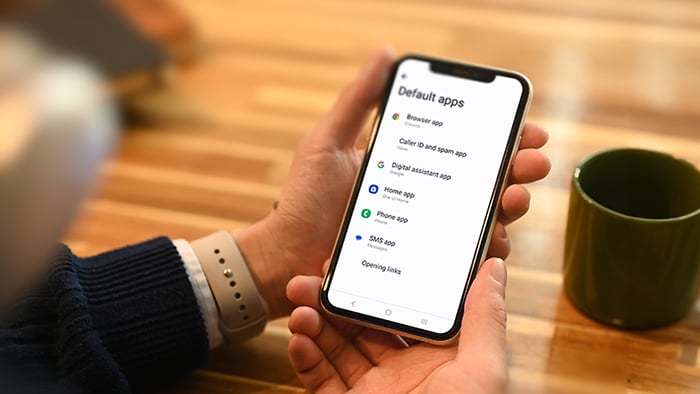How to block websites on Chrome on mobile devices
Blocking websites in Chrome on mobile works differently depending on whether you're using an Android or an iPhone. On Android, you’ll need a trusted third-party app to restrict access. On iPhones and iPads, you can block specific sites directly through Content & Privacy Restrictions in the Settings app.
On Android
The Android version of Chrome doesn’t include a built-in site-blocking feature, and because Chrome runs as a standalone app, your phone’s system settings can’t control which websites it loads. As a result, the only way to block websites in Chrome on Android is to use a third-party app that can filter or restrict web access.
Here’s how to block a website on Chrome on an Android device:
-
Open Google Play and search for, install, and open a trusted site blocker (we’re using BlockSite).
-
Allow the app to access your phone settings and follow the steps to subscribe or try the free version.

-
Tap + CREATE, select from the popular sites suggested or search for the URL you want to block, then tap Done.
-
Select when the block should be active, tap Next, choose an icon and color for your blocked sites group, and tap Done.
-
To add more sites to your blocklist, simply tap + ADD ITEM, find or type the URL, and tap Done.
To quickly deactivate BlockSite, open the app and tap the menu icon in the top-right corner and tap Blocking. Tapping this button toggles the block feature on and off.
To further control what you see online, consider downloading an ad blocker on your Android to help prevent unwanted pop-ups.
On iPhone
iOS users can block websites on Chrome without downloading a special app. This is due to Apple’s app developer restrictions. All browsers on iOS must use Apple’s WebKit engine, which powers Safari. As WebKit is integrated with your iPhone’s system settings, content restrictions can be applied to any browser you use.
Here’s how to block a website on Chrome on iOS:
-
Tap Settings > Screen Time > Content & Privacy Restrictions. If you haven’t set up Screen Time before, you may need to turn it on first.

-
Toggle on Content & Privacy Restrictions and tap Content Restrictions > Web Content.

-
Tap Limit Adult Websites to automatically restrict adult content. To block specific sites, tap Add Website under Never Allow, type the URL, and tap Done.

If you want even more control over what appears on your screen, consider installing an ad-blocking app on your iOS device.
How to block websites on Chrome on desktop
By far the easiest way to block websites on Chrome is by downloading an extension. However, other options include using a Google Admin Account, changing system-level settings, updating your router settings, or applying parental controls.
Whichever method you use, make sure you update Chrome regularly to ensure you’re browsing as securely as possible, and use a browser cleaner to periodically remove third-party cookies and keep your browser running smoothly.
Using a Chrome extension
Extensions are an excellent way to boost your privacy and security when browsing online. And you can easily remove an extension in just a couple of clicks if you find it’s slowing down your browsing or you’re not using it.
Follow these steps to use a website-blocking extension on Chrome:
-
Visit the Chrome Web Store, search for a website blocker extension (we’ll use BlockSite), and click Add to Chrome.

-
Click the BlockSite logo in the top-right corner of your browser. (If you can’t see the logo, click the puzzle icon, which is also in the top-right corner, and click the pin icon).
-
Create an account if prompted, then click Block Sites on the dashboard’s left menu, enter the URL of the site(s) you want to block, and click Add Item.

-
You can also add to your blocklist while you’re on the site you want to ban. Simply click the extension logo and click Block this site in the pop-up window.

BlockSite is just one of many Chrome extensions that can be used to block websites. Other popular site-blockers include:
-
StayFocusd.
-
Freedom.
-
Sidekick.
-
Self Control.
-
PawBlock.
-
XTab.
-
LeechBlock.
Block websites using a Chrome extension in Incognito mode
By default, Chrome extensions are disabled in Incognito mode unless you change your settings to allow them. If you want your blocked website list to restrict browsing while you or your family are using Chrome’s private browsing mode, you’ll need to configure this.
Here’s how to enforce your blocked websites on the Chrome browser when using Incognito mode:
-
Click the puzzle icon in the top-right of your browser > Manage extensions > click Details on the correct extension > toggle on Allow in Incognito.

If you’re keen to make your browsing experience smoother and more private, it’s a good idea to install an ad-blocker to prevent annoying ads and pop-ups while browsing.
Using a Google Admin Account
Google Chrome itself does not offer a built-in option to block websites. But if you don’t want to use a third-party extension, you can use a Google Admin Account to block certain URLs.
This method only works for managed Google accounts, like those in Google Workspace or Cloud Identity domains. It cannot be used with personal Gmail or unmanaged Chrome profiles.
Here’s how to block a website on Chrome without using an extension:
-
Go to admin.google.com and log in to your admin account.
-
In the Admin Console, click Devices > Chrome > Settings > Users & Browsers.
-
Select which users you want the blocking rules to apply to and navigate to the URL Blocking section.
-
Enter the web address you want to block in the Blocked URLs tab and click Save.
Using system-level blocking
You can also block websites on Google Chrome by using system-level methods, such as editing the Windows hosts file on a PC or using Screen Time on a Mac.
These approaches are effective because they block sites at the OS level. However, they involve modifying core system settings, and mistakes can cause issues. A single typo in the hosts file or a misconfigured restriction could block essential sites or disrupt your internet connection.
If you’re not confident with this method, it’s best to avoid it.
Edit the Windows hosts file
On a Windows device, you can block websites in Chrome by editing the hosts file, though you’ll need administrator privileges. The hosts file stores the IP addresses and domain names your system uses when loading websites. By manually adding domains and directing them to a non-routable address, you effectively block those sites from loading.
Here’s how to use the hosts file to block websites:
-
Type Notepad in the Windows search bar, right-click Notepad in the results, and select Run as administrator.
-
Log in to an admin account if prompted and click File > Open.
-
Search C:\Windows\System32\drivers\etc, change the file type to All Files (.*) in the bottom-right corner, and open the hosts file.
-
On a new line at the bottom of the file, type 0.0.0.0 followed by a space, then the URL of the website you wish to block, e.g., 0.0.0.0 www.facebook.com. Add as many websites as you like, each on a new line.

-
Save and exit Notepad, then restart your PC.
Block websites on Mac
If you have a Mac, you can use Screen Time to block specific websites. Screen Time is a built-in tool that lets you set usage rules for yourself or your family, including app time limits, downtime schedules, and website restrictions.
Here’s how to block websites on a Mac:
-
Open the Apple Menu, click System Settings (System Preferences on older Macs) > Screen Time > Content & Privacy, and then switch the toggle to on.

-
Click Content Restrictions (Web Content on older Macs) > Access to Web Content (under the Safari heading) > Limit Adult Websites.

-
Click Customize followed by the + button to add the website URL you wish to block, and then click Done.
Using parental controls
Parental controls help guardians protect minors from unsuitable web content and limit screen time. And the good news is that blocking websites using parental controls is a straightforward process on Mac, Windows, iPhone, and Android devices.
Here’s how to block websites using Microsoft Family Safety on your PC:
-
Go to Settings > Accounts > Family & other users > Manage family settings online and sign in if prompted.
-
Go to the Family Safety page, click your child’s Microsoft account, and select Content filters from the left-hand menu.
-
Under Blocked Sites, type in the URL of the website(s) you want to block, and make sure Filter inappropriate websites and searches is toggled on.

Here’s how to block websites using the Google Family Link app:
-
Open Google Family Link, sign in if prompted, and select your child’s account.
-
Tap Controls > Google Chrome and web (or Content restrictions on some Androids) and toggle on Try to block explicit sites.
-
Tap 0 blocked sites (under the Manage sites heading) followed by + Add a website. Then type the URL of the website you want to block and tap Add.

Using a Wi-Fi router
Most Wi-Fi routers allow users to block URLs on their devices and browsers on their home network. Blocking websites at the router level applies restrictions to every device on the network — an effective option for households, workplaces, or schools.
To access your router’s settings, you’ll need to find your IP address. This is typically on the router itself, but if not, you can find it using Command Prompt or Terminal:
-
On a PC, type cmd into the Windows search bar, press Enter, type ipconfig and press Enter again. Your router’s IP address will be labeled as Default Gateway.
-
On a Mac, press Command + Space, type Terminal, and press Enter. Then type netstat -nr | grep default, press Enter and your router’s IP address will appear next to the word Default.
Here’s how to block websites using your router:
-
Open Chrome, type your router’s IP address, press Enter, and log in using the details sent with your router (sometimes found on the router itself).

-
Go to the Settings page that allows you to block websites. This varies from router to router, but can usually be found under Security > Parental Control.

-
Click New, add the URLs of the websites you want to block, and then click Apply > Finish. The process may vary depending on your router.

What does blocking websites on Chrome do?
Blocking websites on Chrome prevents users from accessing those domains. When a user types in the URL or attempts to click a link to visit a blocked website, the browser will display an error message.
There are several reasons why Chrome users may want to block websites: parents may want to prevent children from visiting unsafe websites, or businesses may block social media sites like Facebook or YouTube to ensure that employees avoid distractions at work.
Internet security software may include system-level firewalls that can help detect and block fraudulent websites that contain malware or infected links on any browser.
Block websites using a secure browser
For stronger protection beyond manual site blocking, switch to a secure browser. Avast Secure Browser helps keep you and your family safe by blocking scam sites, preventing malicious downloads, and protecting your online data. It also helps speed up browsing by blocking ads for faster page loads. Enjoy fast, private, secure browsing for free — starting today.




























